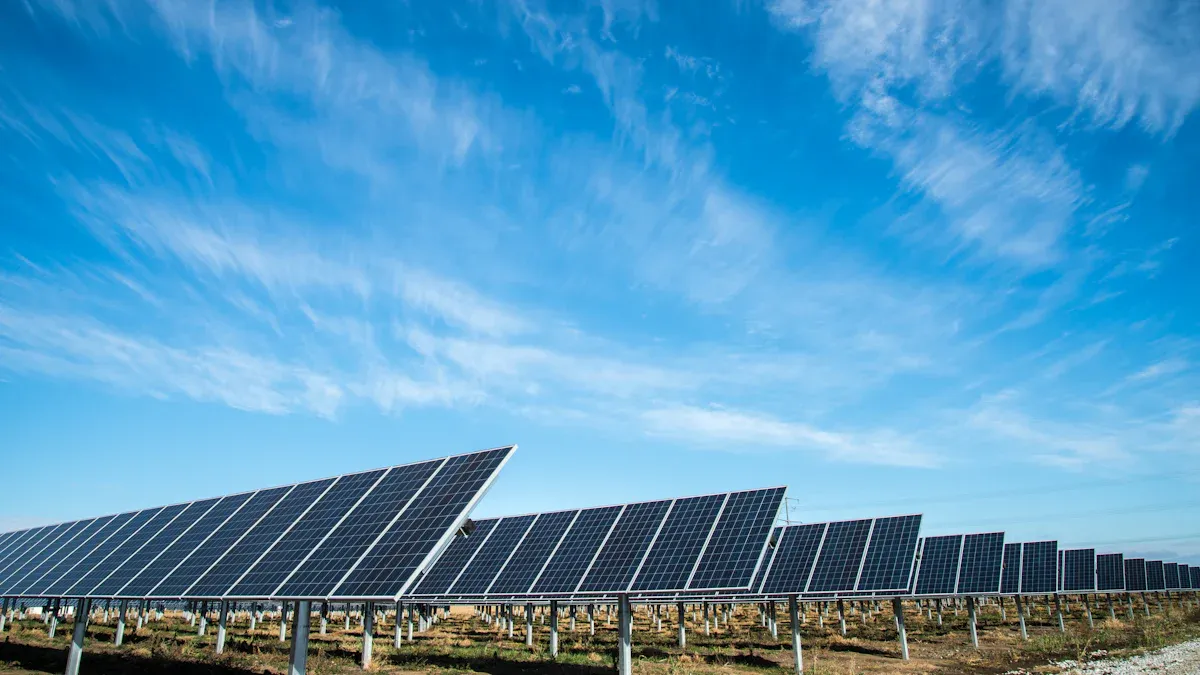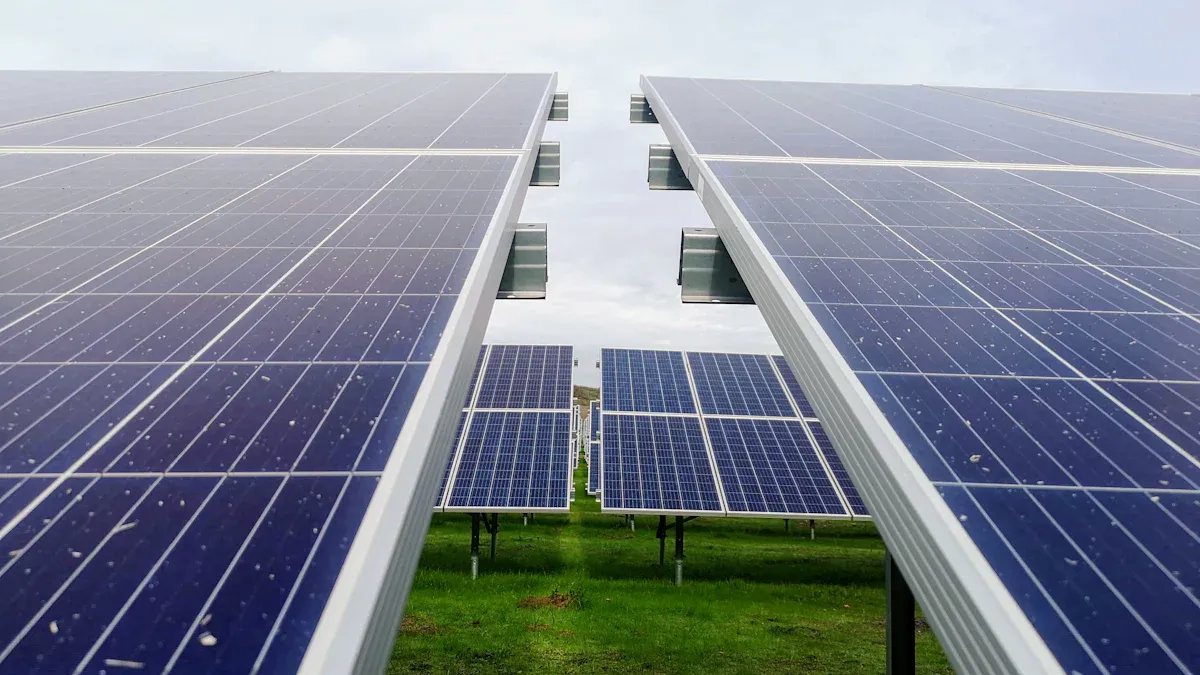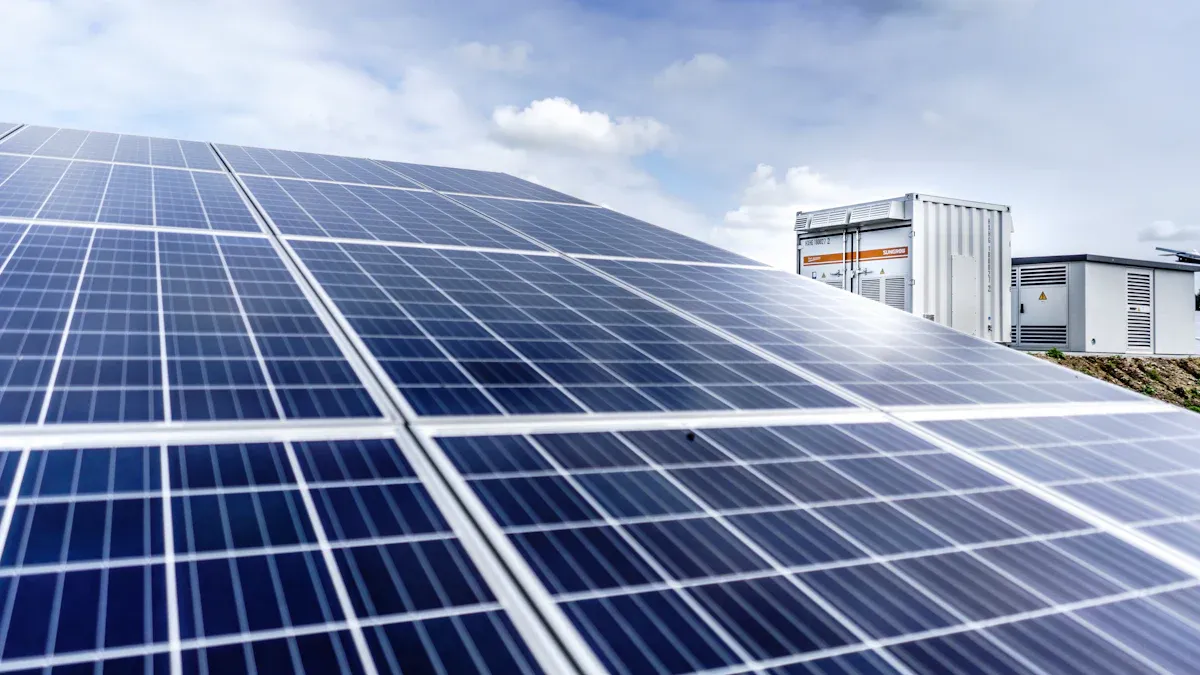What is a Solar Inverter and How Does It Work in 2025?

A solar inverter changes the direct current (DC) from solar panels into alternating current (AC) that powers homes and businesses. Without it, the energy from your panels couldn’t run most devices.
Solar energy has gone from being an extra option to a popular choice. This is shown by its fast growth, lower costs, and use in homes and utilities all over the world.
Here’s a quick look at the rising need for solar inverters:
The Residential Solar PV Inverter Market was worth about 14.85 billion USD in 2024.
It is expected to grow to 16.75 billion USD in 2025.
By 2034, the market might reach around 49.56 billion USD, showing big growth.
This important technology helps you use clean energy and depend less on regular power grids.
Key Takeaways
A solar inverter changes direct current (DC) from solar panels into alternating current (AC) so you can use it at home.
Smart inverters work very efficiently, over 98%, and have tools like Maximum Power Point Tracking (MPPT) to get the most energy.
Picking the right inverter—string, microinverter, hybrid, or power optimizer—depends on your solar setup and how much you want to spend.
Taking care of your inverter and checking it often can make it last longer and work better, saving you money over time.
Knowing your inverter's details and if it works well with your solar panels is important to get the most energy possible.
What is a Solar Inverter?

Definition and Purpose
A solar inverter is the main part of a solar system. It changes direct current (DC) from solar panels into alternating current (AC). This is important because most home devices and power grids use AC. Without an inverter, the energy from your panels can't be used.
By 2025, solar inverters have become smarter and more efficient. They now convert over 98% of energy without much waste. For instance, many inverters include Maximum Power Point Tracking (MPPT) technology. This helps your solar panels work at their best, making more energy. The inverter also checks your system's health, tracks energy output, and keeps everything running well.
Specification | Description |
|---|---|
Efficiency | Converts DC to AC with 93% to 98% efficiency. |
Maximum Power Point Tracking (MPPT) | Boosts solar panel performance for better energy output. |
Startup Voltage | Minimum power needed to turn on the inverter. |
Inverter Size Relation | Should match or be bigger than the solar system size. |
Role in a Solar Energy System
The solar inverter does more than just change electricity types. It controls how energy moves between your panels, home, and the grid. In 2025, smart inverters are a big improvement. They talk to the grid, adjust to energy needs, and help during power changes.
For example, smart inverters check your solar panels' health and track energy in real time. They also share energy with other inverters to balance the system. This is very helpful in areas with disasters, keeping power steady during dips. Plus, modern inverters use artificial intelligence (AI) for predictive maintenance. This means they find problems early, keeping your system reliable and reducing downtime.
Tip: Pick an inverter that works well with your solar panels. A good match improves your system's efficiency and reliability.
In 2025, the solar inverter market could reach $40 billion due to better tech and more users. With over 99% efficiency, inverters now capture solar energy better than ever. Whether for a small home or a big utility system, the inverter is key to using solar power fully.
How Does a Solar Inverter Work?
Conversion of DC to AC Power
A solar inverter changes electricity from your panels into usable power. Solar panels make DC electricity when sunlight hits them. But most home devices and the grid need AC electricity. The inverter handles this important job.
Inside the inverter, special parts switch the current quickly. This creates an alternating pattern that looks like AC. The inverter then uses this pattern to change DC into AC. Modern inverters are very efficient, losing less than 2% of energy during this process.
Here’s how a solar inverter works:
Receives DC Power: Panels collect sunlight and make DC electricity.
Converts DC to AC: The inverter changes this into AC for your home.
Synchronizes with the Grid: If connected to the grid, it matches the grid's voltage and frequency.
Optimizes Performance: Features like MPPT help panels work better.
Provides Monitoring: Inverters show real-time data about energy use and system health.
By converting DC to AC, the inverter makes solar energy useful for homes.
Managing Power Output and Grid Connection
Modern solar inverters do more than change electricity. They also control power flow and connect smoothly to the grid. This is key for systems tied to the grid, where the inverter must match the grid's settings.
Smart inverters can talk to the grid and adjust their output. If the grid has problems, the inverter helps fix them by changing its power. This keeps the system steady and reliable. These features make renewable energy work better with the grid.
Here’s how inverters manage power and grid stability:
Feature | Description |
|---|---|
Fixes issues like flickering or distorted voltage. | |
Grid Support Functions | Helps keep power steady in weak grid areas. |
Smart Communication | Adjusts voltage and frequency based on grid signals. |
Optimization Algorithms | Uses AI to improve efficiency by studying system data. |
Maximum Power Point Tracking (MPPT) | Makes sure panels get the most energy, even in tough conditions. |
These abilities make inverters vital for smooth and efficient solar power systems.
Monitoring and Optimization Features
In 2025, solar inverters are smarter than ever. They now include tools to track and improve your system’s performance. You can see how much energy your system makes and fix problems quickly.
For example, inverters use IoT to let you check your system remotely. You can monitor energy production and find issues using your phone or computer. Better MPPT technology helps panels capture more energy, even in shaded areas.
Here are some new features for monitoring and optimization:
Advancement Type | Description |
|---|---|
MPPT Upgrades | Better tracking boosts energy capture. |
Smart Integration | IoT tools allow easy remote checks and fixes. |
Multi-Channel Tracking | Tracks different panel groups for better energy use. |
Real-Time Data Analysis | Adjusts system performance based on weather or shading. |
User-Friendly Monitoring | Gives clear info to help you make smart choices. |
These updates make inverters more efficient and easier to manage. With these tools, your solar system can run at its best, giving clean energy for years.
Types of Solar Inverters

Picking the right solar inverter is very important. It helps your solar system work better. In 2025, there are different types of inverters for various needs. Let’s look at the most common ones.
String Inverters
String inverters are popular and used in many systems. They link several solar panels in a row, called a "string." This setup changes DC power from the panels into AC power for homes or businesses. These inverters are affordable and easy to fix, making them great for medium or large projects.
Advantages:
Cheaper than other inverters.
Easy to install and repair.
Works well for systems under 25 megawatts.
Limitations:
If one panel is shaded, all panels lose power.
Not ideal for uneven roofs or shaded areas.
Tip: If your panels get steady sunlight, a string inverter is a good option.
Microinverters
Microinverters work differently. Each panel gets its own small inverter. This lets each panel make power on its own. Even if one panel is shaded, others still work well. This setup is great for tricky roofs or shaded spots.
Aspect | Microinverters | String Inverters |
|---|---|---|
Performance in Shade | Excellent; each panel works alone | Poor; shading affects the whole string |
Monitoring Capabilities | Detailed, shows each panel's performance | Basic, less detailed |
Upfront Costs | Higher, costs 20-30% more | Lower, more budget-friendly |
Microinverters are perfect for roofs with odd shapes or shading. But they cost more and take longer to install.
Hybrid Inverters
Hybrid inverters do more than just convert power. They also store extra energy in batteries. This stored energy can be used at night or during cloudy days. Hybrid inverters manage power from solar panels, batteries, and the grid to keep energy steady.
Key Features:
Stores energy, cutting grid use by up to 70%.
Switches smoothly between solar, battery, and grid power.
Advanced MPPT boosts energy capture by about 20%.
Hybrid inverters are great for reducing grid use and gaining energy independence.
Note: Hybrid inverters have advanced features but cost more. Think about your energy needs and budget before choosing one.
Power Optimizers
Power optimizers are small tools that connect to each solar panel. They help your system work better by controlling each panel’s energy output. Unlike string inverters, they stop shading or dirt on one panel from lowering the others' performance.
These devices adjust each panel’s voltage to fit the inverter’s needs. This helps your system make more energy, even in tough conditions. For example, tests show power optimizers boost efficiency by 5% in shaded spots. This makes them useful for homes near trees or tall buildings.
Power optimizers cost less than microinverters but offer similar benefits. Microinverters are pricier, though they also improve energy output. For bigger systems, power optimizers balance good performance with lower costs.
Here’s how power optimizers compare to other inverter types:
Microinverters in California raised energy output by 5-10% in shaded areas.
Power optimizers increased efficiency by 5%, proving their dependability.
They are cheaper than microinverters, making them better for large setups.
Tip: If your roof has shade or uneven sunlight, power optimizers can boost energy without costing too much.
Power optimizers are a smart choice for today’s solar systems. They mix advanced features with affordability, making them popular for homes and businesses.
How to Pick the Best Solar Inverter
Things to Think About (Size, Efficiency, Compatibility)
Choosing the right inverter means looking at a few key things. First, check the size of your solar panel system. The inverter should handle all the power your panels make. For example, if your system makes 5 kW, pick an inverter rated for at least 5 kW. A slightly bigger one is better if you plan to add more panels later.
Efficiency is also very important. High-efficiency inverters waste less energy when changing DC to AC power. Look for inverters with efficiency ratings over 98%. Also, make sure the inverter works well with your solar panels. Check both specs to ensure they match. Features like Maximum Power Point Tracking (MPPT) can help your panels make more energy, even when sunlight changes.
Other things to consider are durability, warranty, and safety. A long warranty shows the inverter is reliable. Built-in safety features protect against electrical problems. If your system connects to the grid, make sure the inverter meets local rules.
Price and Budget Tips
Your budget matters when picking an inverter. Different types of inverters cost different amounts. For example:
Inverter Type | Cost Range |
|---|---|
String inverters | |
Power optimizers | Mid-range cost |
Microinverters | Most expensive |
Hybrid inverters | Higher, varies |
String inverters are the cheapest and good for tight budgets. Microinverters and hybrid inverters cost more but have extra features. These include better panel performance and energy storage. Think about how these features might save money in the long run.
To get the best value, compare the Levelized Cost of Electricity (LCOE) and warranty terms. Spending a bit more upfront can save money later with better efficiency and longer life.
Installation and Care Needs
Different inverters need different levels of work to install and maintain. String inverters are easy to set up and fix, making them a common choice. Microinverters take more time and effort since each panel needs one. But they make fixing problems easier by isolating them to a single panel.
Hybrid inverters, which store energy, may need special skills to install. Regular care, like cleaning and checking connections, keeps them working well. Many modern inverters have monitoring tools. These tools alert you to problems, saving time and repair costs.
When planning your solar system, think about how much work your inverter will need. Taking care of your inverter helps it last longer and keeps your solar system running smoothly.
Benefits and Challenges of Solar Inverters
Advantages of Using Solar Inverters
Solar inverters are key to using solar energy at home. They change energy from solar panels into electricity you can use. This makes solar power a great option for homes and businesses.
Solar systems with inverters are efficient and save money. They make more power at lower costs than regular energy sources. By cutting greenhouse gases, they help the planet and reduce the need for fossil fuels. You can install them almost anywhere, like city rooftops or far-off places.
Smart inverters make these systems even better. They check solar panel voltage and adjust for shading or wear. This keeps energy production high, even in tough conditions. Smart inverters also talk to the grid, helping balance power and improving efficiency.
Benefits | |
|---|---|
On-grid Inverter | Cuts electric bills, supports net metering, uses grid as backup |
Off-grid Inverter | Works without the grid, offers energy independence |
Hybrid Inverter | Stores energy, provides backup power |
String Inverter | Affordable for big setups, simple to use |
Microinverter | Tracks each panel, works well even with shading |
Power Optimizers | Reduces shading problems, boosts energy output |
Tip: Picking the right inverter type helps save money and energy.
Common Challenges and How to Address Them
Solar inverters are helpful but come with some challenges. Knowing these issues and fixing them can keep your system working well.
One problem is equipment breaking down, which can cost more over time. Regular checks and maintenance can prevent this. Hiring a technician for routine inspections helps your inverter last longer. For smaller systems, cleaning panels yourself can save money.
Another challenge is the high upfront cost, especially for hybrid or microinverters. These types have advanced features but can be pricey. To handle this, think about how much money you’ll save later with better efficiency and less grid use.
Shading and uneven sunlight can also lower performance. Microinverters and power optimizers solve this by letting each panel work on its own. This way, shading on one panel doesn’t affect the others.
Challenges | Resolutions | |
|---|---|---|
Solar system reliability | Equipment failures raise costs | Use better tech and plan maintenance well |
Life Cycle Cost (LCC) analysis | High maintenance costs | Schedule regular checks to avoid big repairs |
Inverter importance | Some parts fail faster | Clean panels often to lower upkeep costs |
Note: Smart inverters with monitoring tools can spot problems early. Fixing issues quickly saves both time and money.
Solar inverters are crucial for clean energy, but solving their challenges keeps your system running for years.
A solar inverter is key to turning sunlight into usable power. It helps your solar system work well and stay reliable. Picking the right inverter affects how much energy you get and how long it lasts. Studies show European inverters keep steady output, with small drops in year one due to part changes.
Why Picking the Right Inverter is Important:
A bad choice lowers energy production.
Experts say internal parts impact how efficient it is.
Think about your energy needs closely. Talk to experts to find the best inverter for your system to work its best.
FAQ
What is the lifespan of a solar inverter?
Most solar inverters last between 10 and 15 years. Advanced ones can work up to 20 years with good care. Regular checks and cleaning help them last longer.
How do I know if my solar inverter is working properly?
Look at the inverter’s screen or use its app. It should show energy data. If there are error messages or no power, something might be wrong. Call a technician to check it.
Can a solar inverter work during a power outage?
Normal inverters stop working during outages for safety. Hybrid inverters with batteries can give backup power. Pick one if you need power during blackouts.
How often should I maintain my solar inverter?
Check your inverter at least once every year. Keep the area clean and look for error signs. Many inverters today can alert you to problems on their own.
What happens if my solar inverter is undersized?
A small inverter can’t handle all your panels’ power. This wastes energy and lowers output. Always pick an inverter that matches or is slightly bigger than your system.
See Also
Telecom Cabinets Powered By Grid-Connected Solar Inverter Systems
Energy Storage Solutions For Telecom Cabinets With Smart Microgrid
Innovative Outdoor Communication Cabinets Designed For Sustainability In 2025
Solar Energy Storage Systems For Efficient Telecom Cabinet Power
CALL US DIRECTLY
86-13752765943
3A-8, SHUIWAN 1979 SQUARE (PHASE II), NO.111, TAIZI ROAD,SHUIWAN COMMUNITY, ZHAOSHANG STREET, NANSHAN DISTRICT, SHENZHEN, GUANGDONG, CHINA

